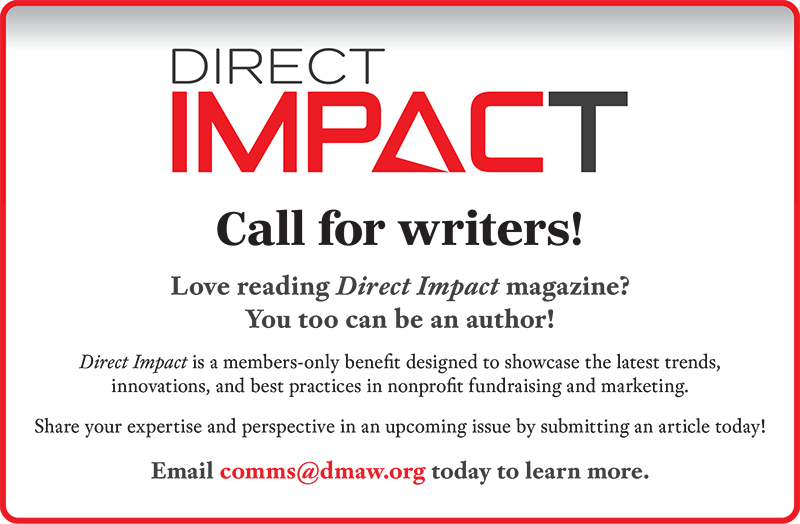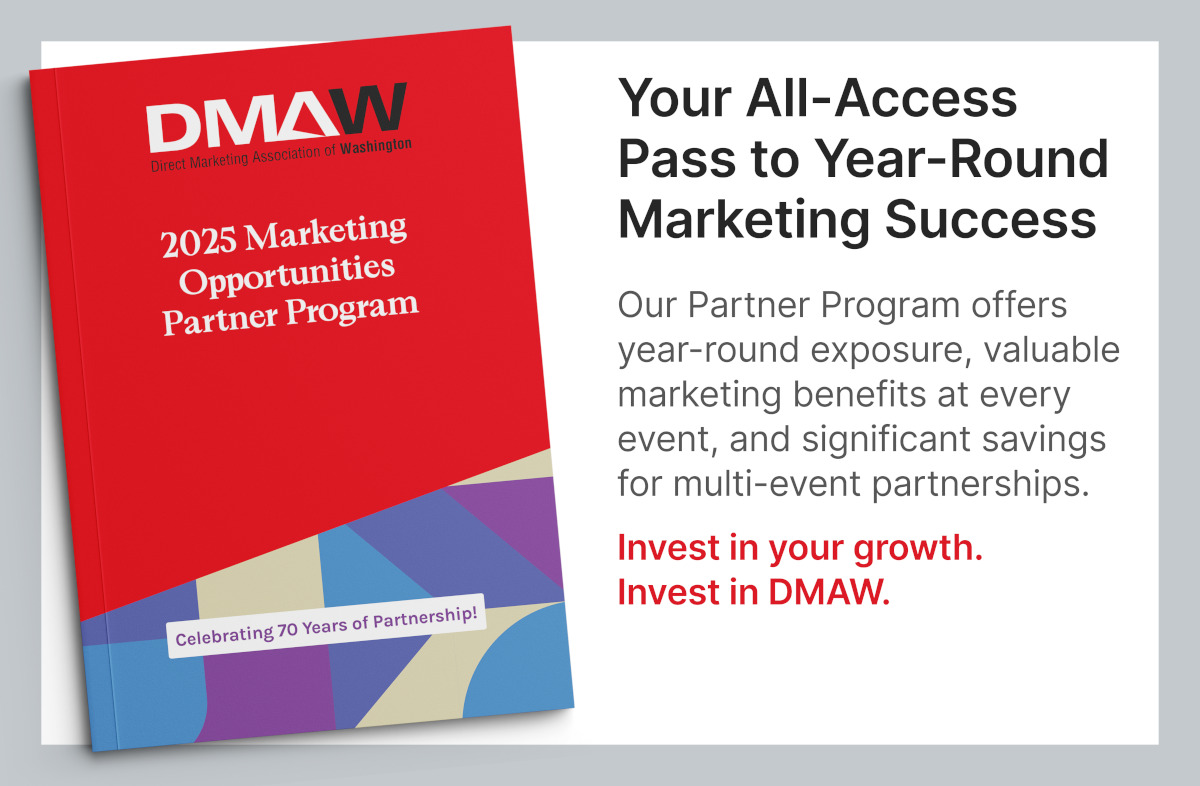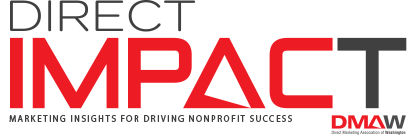
March/April 2025 • Vol. 63 No. 2
Articles
Columns
Featured Event
Getting the Most Out of Your Lapsed Donors: A Case Study
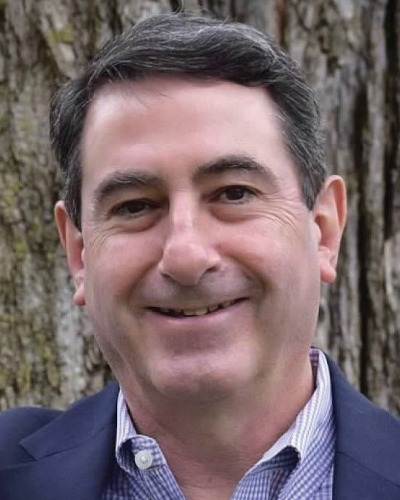
Having been in the direct mail field since it was considered "king of fundraising" and the best way to market to donors, I have worked with some intelligent marketers and learned a thing or two. Many organizations and their boards mistakenly believe direct mail has lost its impact in fundraising. In the direct mail realm, we know that donors give via U.S. Postal Service mail, but that what they receive in their mailboxes also has a major impact on online and planned giving.
That’s why as direct mail marketers it’s imperative we always look for ways to improve response performance, average gift and key performance indicators. This is especially true when it comes to reinstating lapsed donors. Data shows that a lapsed donor who reinstates with an organization has a higher long-term value (LTV) than newly acquired donors. This is why Humane World for Animals (formerly called the Humane Society of the United States) reached out to a vendor partner of ours to create a model that would help us achieve those metrics.
In January 2024, we tested our lapsed donor model. The model was applied to 25-month to 48-month lapsed names. Our target was to reach out to these lapsed donors via our reinstatement/lapsed donor campaign with a custom developed machine learning model to refine the targeting.
The model was built by combining data from past lapsed campaigns and rich information about our donors from our constituent relationship management (CRM) system. This included traditional attributes around recency, frequency and amount of past giving, as well as many other variables focused on giving channels, donor outreach and attributes indicating donor engagement with our mission. The training set also included demographic attributes we store in our CRM as well. No external data was appended to the training set.
Against this training set, we evaluated a variety of different machine learning algorithms to see which would provide the best results when measured against holdout campaigns in a back test. The model we selected to test balanced both response and expected gift amount to rank our file in a way that balanced both considerations.
The objective of our test was to produce a higher response rate renewing more lapsed donors, while having little to no effect on the average gift. Our objective was to maintain a $25 average gift, knowing that is the threshold for a better long-term value.
Donors were mailed a membership package with a member card and a back-end premium offer. The test included modeling and generating a score for the 425,000 lapsed donors on our file with their most recent gift being between 25 and 48 months. We were provided decile scores in categories of one to 10, giving each decile a probability to reach our intended goal on a hierarchical pyramid. For the campaign, we used these model decile scores to select which names to mail, but skewed the selections toward names predicted to have the best results. For clarity, we selected some names from every decile, weighting our selection toward the names in the top predicted deciles to validate the model.
As a result, we mailed 293,000 names, less than our budgeted 325,000 names. The results, when compared to the budget, were an increase in response rate by almost 1% and an additional 2,200 responses.
For clarification, this was not a head-to-head test with another model or names that were not modeled. We applied model scores to the entire audience. Instead, results were analyzed year over year to our 2023 membership card results and compared to our yearly budget.
The model results look solid, showing strong spread and model effectiveness at ranking donors based on response and expected gift probability. Validation results confirmed the model is effectively ranking lapsed donors.
These test results gave us enough confidence to roll out with the model in additional mailings throughout the year, and we have continued to see improved performance.
It’s exciting to see the data industry leveraging cutting-edge machine learning technologies to adapt to the challenges at hand. They are working with organizations to leverage the data we are already capturing in our CRM to create better models that drive growth in active donors, retention and revenue.
Don’t be afraid to work with your data partner by letting them know exactly what your needs and wants are. They have the data, the algorithms and knowledge to set your organization on the path forward.
Jim Aber is the program director of acquisition mail at Humane World for Animals. He oversees and manages the direct mail acquisition and reinstatement programs for the organization.
PRESIDENT’S PERSPECTIVE
Celebrating 70 Years: Innovating Connections, Inspiring Change
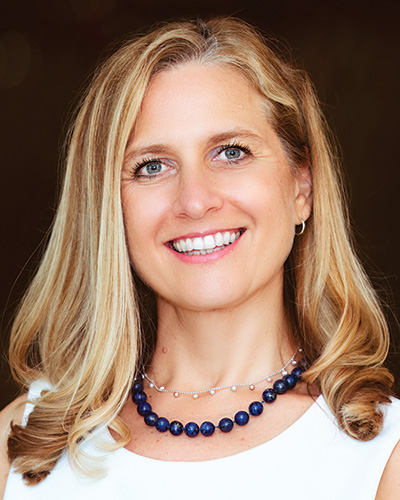
Spring is in the air. And in my house, that means baseball!
I love going to the first game of the season. It feels like coming home in some ways. My home field is Nats Park and catching a glimpse of the field as I enter the ballpark for the first time in any season is a rush. There is always excitement in the air, new players on the field and possibilities for a new season.
I find there is a lot of similarity between direct response fundraising and baseball.
A new season is like a new fiscal year. The initial roster is your annual plan and budget. The team’s farm systems is like an investment in your program (acquisition, cultivation, stewardship). You might have some big power hitters (major donors) and some utility players who are consistent and reliable (sustainers.) And you probably have this all down on paper at the start of the year.
The comparisons extend beyond comparing the players to your types of donors. The general manager and base coaches are your director and program leads. The back office is pulling your data, managing schedules and quality controlling the plan.
Hitting your marks and bringing your A game is a team effort. Your team members need to talk to each other, sync up their strategies and ensure the information is shared. Every member of the team — those on the field and those in the back office — all have an important role to play.
In baseball, there is a symbiotic relationship between the pitcher and the catcher. But the entire team is watching and reacting in sync. The outfielders keep the game in check and when each player comes to bat, there is a new chance for progress and a chance to score.
It is the same with our work. There is a unique relationship among the campaign strategist, the copywriter and the designer. Each campaign is a new chance to convert a warm prospect to a new donor, drive revenue and to upgrade donors. It’s like getting a batter on base, and then to second, and then all the way home.
The best fundraising programs benefit from diversity — small-dollar, mid-level, major and recurring donors. And those donors are acquired via direct mail, display advertising, social media and even peer-to-peer efforts or events.
And the best baseball teams have diversity of skill — big bats, base stealers and a sacrifice here or there to advance a larger play.
The DMAW is here to make sure you and your team have the skills that ensure your team and your program are successful. This month’s Direct Impact features some of our best teammates too — the USPS and postal discounts, a great story on audience and sustainer modeling to help grow your recurring giving efforts and a MAXI spotlight — among other great articles.
Plus, your creative team will benefit from our upcoming Creative Day (May 7). Of course, education and professional development isn’t complete without the Bridge Conference — celebrating its 20th year. Registration is open.
Whether you love baseball like I do or you just love our industry (which I also do), an appreciation for the complex work we do and the dedicated people with whom we do it makes me happy that I get to be part of our larger team.
I’d love to hear your thoughts on this — unless you are a Phillies fan. Just kidding.
Karin Kirchoff
President, K2D Strategies
kkirchoff@k2dstrategies.com
Committee Spotlight
Get to know the people behind the scenes powering our industry’s top events and programs, and how you too can get involved.
Direct-ly Shaping the Future of DMAW

The Marketing Committee of the Direct Marketing Association of Washington (DMAW) has geared up for an exciting 2025 with a renewed focus on enhancing the organization’s value proposition and strengthening its connection with members across all levels of experience.
Sharpening the Value Proposition
One of our top priorities is to refine and amplify DMAW’s value proposition, particularly the critical importance of direct marketing. In today’s rapidly evolving marketing landscape, staying ahead of the curve is crucial. Staying focused is even more crucial, and we believe that nonprofit direct marketing professional development is more important than ever.
DMAW recognizes that nonprofit organizations face unique challenges and opportunities in direct marketing, and is committed to providing targeted resources and education to help these leaders excel.
Programming to Two Primary Audiences
Another key focus for the Marketing Committee is to ensure there is a tight connection between DMAW’s marketing strategy and its program decisions. You will see education content and networking opportunities that focus on two primary audiences:
High-Level Strategic: Programs tailored specifically for senior nonprofit leaders will delve into advanced topics such as multichannel integration, data-driven decision-making and emerging technologies in direct marketing.
Foundational Upskilling: Recognizing the importance of nurturing the next generation of direct marketing professionals, DMAW will offer an expanded range of 101- and 201-level content. These programs will cover essential direct marketing principles, best practices and practical skills that emerging nonprofit leaders can immediately apply to their work.
This two-pronged approach ensures that DMAW continues to serve as a valuable resource for direct marketing professionals at all stages of their careers, from newcomers to seasoned experts.
Celebrating Members
Do you remember Members Only jackets? I may or may not still rock one, every now and again. You might say they are making a comeback. I say they never went away. There’s something iconic, to me, about that “Members Only” tag sewn on the jacket pocket. It feels good to be a member and to feel a part of something.
DMAW’s greatest strength lies in its diverse and talented membership base. To that end, we plan to more prominently feature and celebrate DMAW members across various platforms. I’m excited to see us continue the strategic use of Facebook and LinkedIn to extend a member-first community mindset to all that we do — and to spotlight members regularly so we all learn a little more about them.
Looking Ahead
As DMAW celebrates its 70th anniversary in 2025, the Marketing Committee is committed to honoring the association’s rich history while propelling it into the future. The committee’s initiatives are designed to ensure that DMAW remains at the forefront of direct marketing excellence, providing unparalleled value to its members and the broader nonprofit community.
I’m honored to be a part of this committee, alongside the phenomenal volunteer team of:
- Brenna Holmes, BH Advisory Consulting (Marketing Technology)
- Leigh Corrigan-Owens, Mal Warwick Donordigital (DMAW’s Blog)
- Olga Moshinsky Woltman, Lemon Skies (Social Media)
- Amy Spears, Boys Ranch (Email Marketing)
If you’re looking for a way to contribute to the sector, consider volunteering for the Marketing Committee. We’re always looking for creatively minded individuals.
Justin McCord is the chief of staff and head of Marketing at RKD Group.
Bridge 2025: 20 Years of Growth (and a Sneak Preview)

It’s hard to believe for many of us, but the 2025 Bridge Conference will celebrate its 20th birthday this year. Before we look forward, let’s take a quick look back.
July 12, 2006
George W. Bush was president. Headlines that day fretted over the rising price of gas ($2.93 a gallon). Six years ahead of Superstorm Sandy, weather analysts predicted a “killer storm” on the northeast coast. Scientists reassured the public that bird flu was not likely to morph into a human form but admitted it was continuing to evolve. We were still two-plus years away from a recession and 13-plus years away from a pandemic, both of which would have profound impacts on our industry. And, in what may represent the 2006 peak of human fallibility, a 23-year-old woman handed her stolen fake ID to the bar waitress she’d stolen it from a month earlier to prove she was over 21.
Something else occurred on July 12, 2006.
The first-ever Bridge Conference kicked off at the now-long-gone Marriott Wardman Park Hotel. It was co-sponsored by DMAW and AFP DC, which decided to blend DMAW’s Annual Conference and Expo and AFP’s Fundraising Day into one combined event. They named it the 2006 Bridge to Integrated Marketing and Fundraising, and its theme was “Merge for Strength.”
I recall much chirping at the time that a long name like that would never stick. Wrong. (See human fallibility above.) The event was an immediate success. Co-chaired by Geoff Peters, president of CDR Fundraising; and Nancy Withbroe, CFRE, president of Withbroe Development Consulting, it offered the 624 attendees 72 educational sessions in nine tracks, more than 100 speakers, 24 corporate sponsors and 105 companies exhibiting in booths or table tops.
July 2025: A rallying cry
It’s been an eventful 20 years, to say the least. The recession and pandemic left us all reeling, of course, but also chaotic social upheavals, spiraling inflation, cataclysmic natural disasters, wars and ominous political movements worldwide have all negatively influenced charitable giving.
This year’s theme, “Ignited by Purpose,” is a rallying cry — a return to the passion and perspective that fueled (and continues to fuel) us as we address the world’s toughest problems.
The vital qualities we must engage to deliver the missions we serve are captured in the 2025 theme tagline: Vision. Innovation. Unity.
“Purpose ignites vision, innovation and unity like a spark setting transformation into motion,” Chris Weiland, group creative director at RKD Group, who developed the theme, said. “The theme celebrates the dynamic interplay between individual passion and collective vision.”
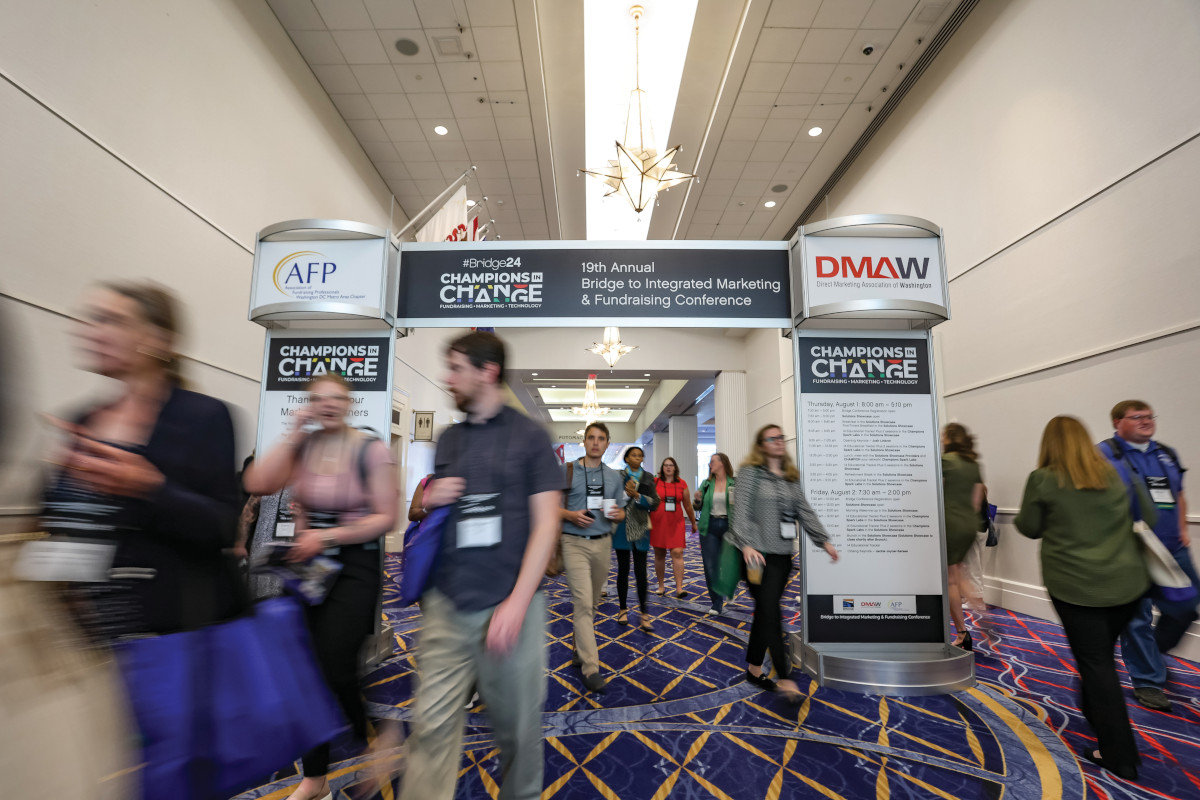
The Bridge Conference Today
Through it all, the Bridge Conference continues to grow. DMAW and AFP DC are still co-hosts. Last year, the Bridge Conference attracted more than 2,700 registrants while serving them with a broad array of invaluable resources. Clearly, the support the Bridge Conference provides is more important and valuable than ever. And 2025 is proving to be record-breaking:
- 15 educational tracks, offering more than 105 sessions (including those in the Solutions Showcase)
- Specialty tracks: Faith & Fundraising, BridgeTECH, Professional Development and — new this year — International.
- More than 300 speakers
- More than 40 corporate sponsors
- More than 140 exhibiting companies
More to Come
Registration is now open at bridgeconf.org. There is no better time than now to secure your spot at the 2025 Bridge Conference. As we get closer to the event, monitor future issues of Direct Impact, your email, the DMAW website and the Bridge Conference website for more information — including keynote speakers, tips on preparing for a truly valuable Bridge experience and perhaps a hint (but only a hint!) about our planned 20th birthday festivities.
See you at Bridge!
John Thompson is the chief marketing officer at TrueSense Marketing. He is also serving as the 2025 Bridge Conference co-chair.
Delivering Performance: The Dynamics Shaping the Future of Omnichannel Marketing
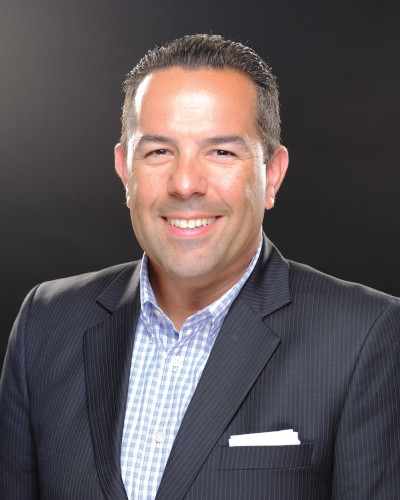
Consultants work feverishly to address nonprofit demand for new marketing strategies. These efforts are powered by a combination of emergent technology and captivating content that both build awareness and deliver clear, incremental outcomes — breaking through outmoded distinctions of upper- and lower-funnel campaigns.
Hunched over their keyboards and spreadsheets, digital advertising professionals are wrestling with the skyrocketing cost of online media — and the declining addressability of the data that was not long ago so widely available to help identify and engage online donors.
And hunkered down with their product road maps, fundraisers are seeking solutions to fund their missions amid a vast, but deeply fragmented universe of potential donors.
Whether huddled, hunched or hunkered, what all three groups share is a common mission that’s growing among marketers everywhere: the pursuit of new, breakthrough forms of performance in an environment where fragmented media, technological disruption and competitive pressures are constantly raising the cost and complexity of managing effective marketing programs. Perhaps not surprisingly, many are responding in similar fashion: by taking steps to tear down legacy silos — operational, technological and budgetary — with an eye on better managing those touch points that drive growth and power improved experiences.
In recent years, some have come to call that effort “digital transformation.” But savvy operators are now pursuing such change with the aim of incorporating all addressable channels into marketing programs that benefit from the disruptive contributions of data and technology — and offer the kind of lasting performance benefits that support bottom-line business goals.
Transformation, for sure — but not exclusively digital. Direct mail has long played an important part in driving marketing outcomes, but today it is increasingly being leveraged as a central component of orchestrated, omnichannel programs that many marketers say represent the ideal way forward to addressing the cost and complexity issues that have otherwise made their jobs so difficult.
In late 2024, Winterberry Group launched a widespread research effort aimed at better understanding how omnichannel strategies are evolving — and what role, in particular, direct mail stands to play in a more complex mix of touch points aimed at supporting customer acquisition, incremental sales, fundraising and other use cases. Here are a few of the key findings we discovered.

Brands Remain Committed to Investing in Direct Mail
U.S. marketers invested approximately $37.3 billion in the channel in 2024 (representing 2.6% growth in expenditures from the previous year), and 81% intend to grow their spending on direct mail in 2025.
Declining Direct Mail Volume Reflects a Strategic Shift
Brands’ growing focus on investments that support clear, incremental performance outcomes is concentrating marketers on the value unlocked by direct mail. This allows many to seek efficiencies by shrinking the volume of their underlying programs (even as they maintain or grow their total financial investment in the channel).
Rising Costs Significantly Impact Direct Mail Budgets
The steady growth of rates in recent years has forced brands to devote a growing proportion of their direct mail budget — now 50.2% — to postage expense. But a vast majority, some 97% of marketer panelists, said they’re likely to maintain or grow their aggregate direct mail budgets even in the face of potential rate hikes in the future — leveraging a combination of technological innovations, supply-chain efficiencies and alternate formats as means of offsetting higher delivery costs.
Brands Have Made Significant Progress in Dissolving Legacy Silos
These legacy silos have long distinguished how they managed various marketing media, but an attribution gap continues to stand in the way of direct mail’s deeper omnichannel integration. Marketers identified “greater integration in cross-channel media measurement/attribution” as the single unrealized initiative that would most significantly advance the value of their direct mail investments.
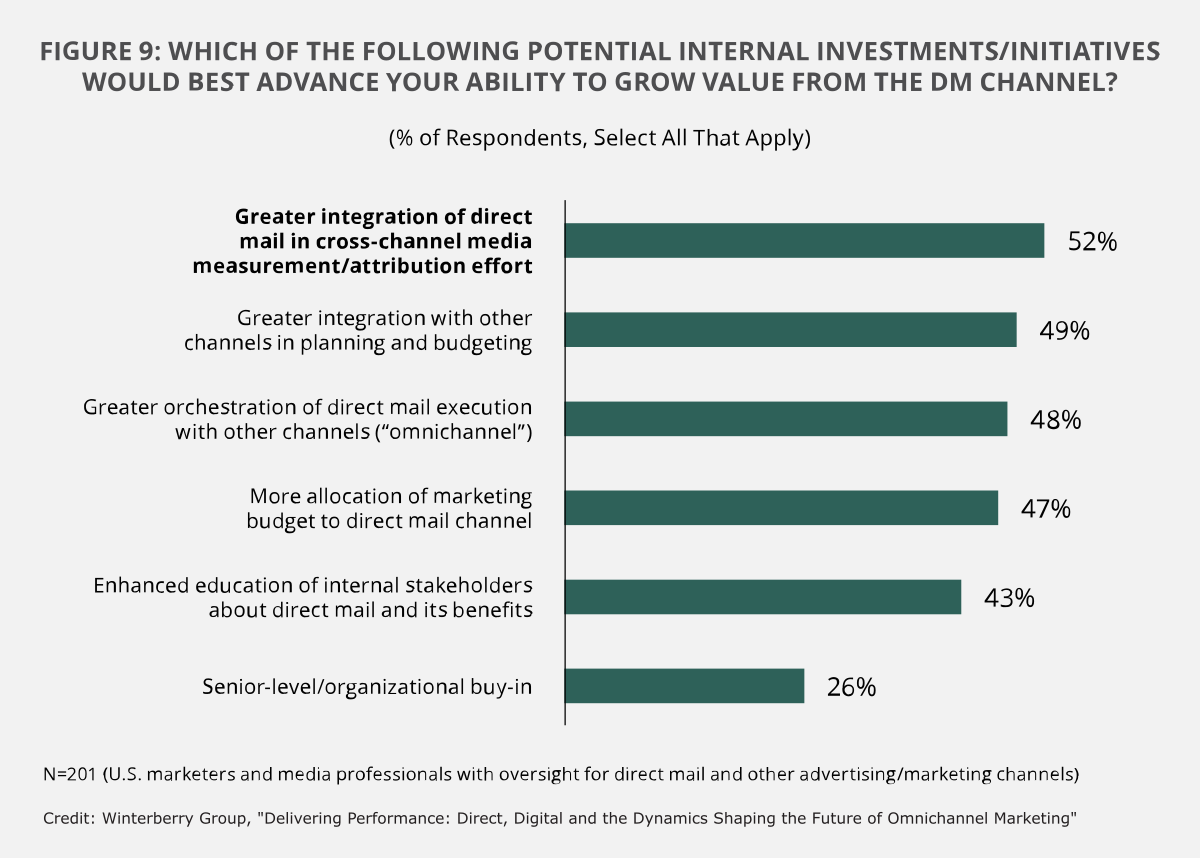
Emerging Innovations Drive Omnichannel Gains
While enthusiasm abounds for the long-term disruptive potential of AI, marketers are already realizing meaningful performance gains from more incremental, technology-enabled direct mail innovations. More than 60% of marketers said their organizations have already deployed certain tools and methodologies — such as retargeting based on digital data, integration with third-party marketing technologies, use of behavioral triggers and integration of QR codes — aimed at driving greater impact of their direct mail efforts and complementing their online marketing efforts.
Adapting to those dynamics (and maximizing the value of their direct mail investments in concert with performance-oriented strategies) will require brands to take a proactive approach to their own omnichannel activation in years ahead. In particular, our research suggests that marketers across verticals should consider each of five core imperatives:
- Recognize and manage direct mail as a core performance marketing vehicle.
- Enable an ongoing cross-channel “measure-and-test” capability.
- Invest in data-driven technology solutions that incorporate holistic campaign planning and extend through deployment.
- Understand and develop a plan to apply generative AI and machine learning.
- Consider the ideal evolution of current operating silos.
To read the entirety of the report, “Delivering Performance: Direct, Digital and the Dynamics Shaping the Future of Omnichannel Marketing,“ visit winterberrygroup.com/insights.
With an extensive background in strategic planning and executive-level advocacy, Jonathan Margulies is a managing partner and leads research and thought-leadership initiatives for Winterberry Group, a growth consultancy specializing in marketing, advertising, technology, data and analytics. He has spearheaded the development of more than three dozen high-profile research publications and economic analyses and has led over 100 intensive consulting engagements. He previously served as communications director for a 10,000-member New York City labor organization. He received a Bachelor of Science in economics, with a concentration in management, from the Wharton School at the University of Pennsylvania.
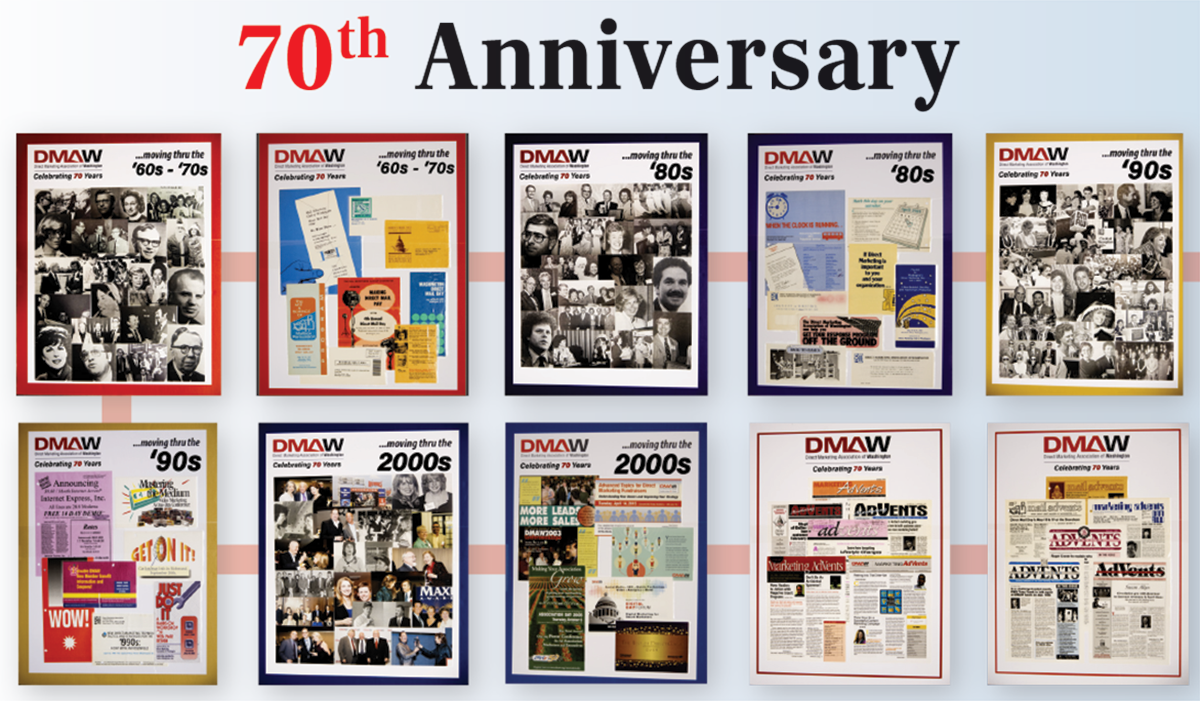
MAXI Award Winners: Fundraising Workhorses and One Very Big Idea

We are excited to feature three of our 2024 MAXI award winners in this issue of Direct Impact. Read carefully to find an idea or two that could boost response in your next campaign.
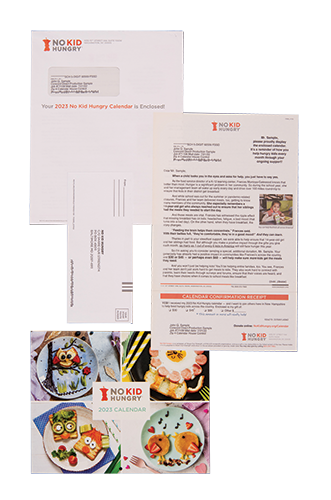
No Kid Hungry Calendar Acquisition
Silver Workhorse Winner
OK, sure it’s a calendar package and you may be asking, “What’s so special?” Everyone knows that calendars are really effective in direct mail. But what makes this calendar stand out is that it’s been the control acquisition package in the July time slot for seven years running. It’s a true workhorse. The folks at No Kid Hungry found a winning combination when they combined food and art in the pages of their calendar. People love the food art. It’s quirky and fun. In 2023, with a 2.5% acquisition response rate, the cost to acquire a new donor was just $23.
Why did it work?
- Food-themed art on every page of the calendar — people love food!
- Food-themed art on every page of the calendar — people love art!
- A simple, story-driven one-page letter that paints a picture of childhood hunger.
- Reply form copy employs social proof and localization by encouraging donors to join others in their state in supporting No Kid Hungry.
Congrats to Concord Direct and the team at No Kid Hungry for this MAXI win.
National Audubon Society, Annualized Renewal
Silver Workhorse Winner
OK, sure it’s a calendar package and you may be asking, “What’s so special?” Everyone knows that calendars are really effective in direct mail. But what makes this calendar stand out is that it’s been the control acquisition package in the July time slot for seven years running. It’s a true workhorse. The folks at No Kid Hungry found a winning combination when they combined food and art in the pages of their calendar. People love the food art. It’s quirky and fun. In 2023, with a 2.5% acquisition response rate, the cost to acquire a new donor was just $23.
Why did it work?
- Targeted messaging — a special letter to recent, loyal donors (10-plus gifts) and faux handwritten notes to $100-plus donors helped boost response to these important segments.
- A letter citing many urgent threats to birds.
- A matching gift.
- A full-color brochure reminding donors of the free gifts that come with their Audubon membership.
Congrats to O’Brien Garrett and the team at National Audubon Society on their workhorse MAXI win.

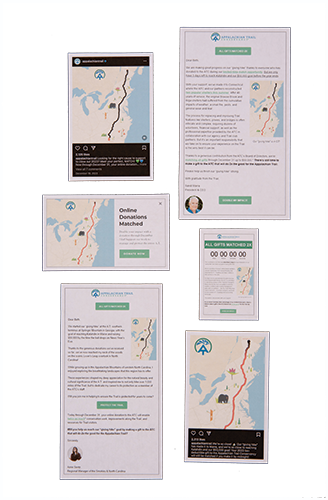
Appalachian Trail Conservancy Year-End Giving Hike
Big Idea Winner
When you know that lots of your donors like hiking, why not invite them to join you on a virtual hike? That was the core idea behind this winning year-end digital multichannel campaign — a “Giving Hike.” The team at Appalachian Trail Conservancy created a fun visual of the Appalachian Trail, which filled in as completed when gifts came in. This tool also created great opportunities to spotlight different states and locations along the iconic Appalachian Trail to inspire even more regionalized engagement. The result? The campaign nearly quadrupled revenue from the year before, and inspired new donor and reinstated gifts. Of the gifts made, 19% came from new donors and 38% came from lapsed donors.
Why did it work?
- Brilliant creative tying the core mission of the organization (the trail) to a fun interactive, gamified fundraising campaign.
- A two-times matching gift well-connected to the goal of completing the trail by the deadline.
- Personal stories from staff members sharing their trail experiences.
- Special variable language for new and lapsed donors.
Want to win your own MAXI? You can submit your best campaign for a 2025 Marketing Awards for eXcellence and Innovation. Visit dmaw.org/maxis to learn more.
Kathy Swayze, CFRE, is president and creative director of Impact Communications, a fundraising agency focused on great storytelling, mid-level fundraising and planned gift marketing. Contact Kathy at kswayze@impactdc.com.
Plan Smart, Save Big: Maximizing Postal Promotions in 2025
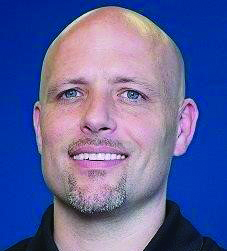
Anyone working in direct marketing in recent years knows that postage costs continue to go up twice a year and, for the foreseeable future, it doesn’t look like that’s going to change. Sure, we can continue to hope that somehow politicians step in and get things right with the U.S. Postal Service (USPS) and Postmaster Louis DeJoy — but don’t hold your breath.
The good news is USPS continues to propose new ways to save money on postage each year via promotions and incentives. Also, these promotions are a good way to innovate and enhance the value of your direct mail efforts — and hopefully that translates into increased response.
While you can do a simple search online to find resources and content pertaining to the promotions, the best place to start is with USPS to get the information directly from the source: postalpro.usps.com/promotions.
There, you can determine when each promotion starts and stops, as well as the promotion’s associated postage discount. The promotions’ calendar includes links to guidebooks for each individual promotion that dive into greater detail on everything you need to know (i.e., what qualifies, how to register, mailing submissions, approvals).
It also includes a resources tab with links to frequently asked questions, webinars and other information, as well as a link to a promotion suggestion form in case you have a great idea for a USPS promotion that should be implemented in the future.
Here is how to make the most of upcoming promotions — in a nutshell.

Integrated Technology
This promotion runs for six consecutive months and the best part is you can pick when that six-month window begins.
The two simplest ways to capitalize on this promotion are in the use of QR codes or artificial intelligence (AI). If you’re already utilizing QR codes to drive people to your donation page (which must be optimized for mobile) or using AI to produce any copy or imagery for your mailings, then you should be good to go.
Here’s an additional tip: Schedule this promotion for your program’s highest volume months of the year to maximize savings.
Tactile, Sensory and Interactive
Using specialty inks, spot gloss, embossed stocks, or membership cards? This may be the promotion for your program. It started Feb. 1 and runs through the end of July.
Continuous Contact
Because this is the newest promotion, details are still being sorted, but, if you mail to the same audience monthly — think about your renewal or appeal programs — you don’t want to miss this offer. It runs from April 1 through the end of the year.
Reply Mail IMbA
Want to see anywhere from a 3% to 6% discount? Convert your existing reply mail to Qualified Business Reply Mail (QBRM) with Intelligent Mail barcode Accounting (IMbA) to receive waived fees and quicker handling.
Learn more at postalpro.usps.com/imba-fact-sheet and postalpro.usps.com/node/13113.
First-Class Mail Advertising
If you are still utilizing first-class mail for major donor or high-dollar donor mailings, then you should consider this promotion to receive the additional discount.
Informed Delivery Add-on
What has been the most popular promotion to date, is now one of two new add-on promotions. This means it can only be used in conjunction with one of the previously mentioned core promotions.
While the downside is that this is no longer a standalone promotion and the discount is only 1%, it is, however, the first time the USPS has allowed multiple promotions to be used at the same time. Plus, it runs for the entire year.
Sustainability Add-on
Like Continuous Contact, this is another brand-new promotion, but it’s an add-on like Informed Delivery. Therefore, it can only be used with one of the main promotions. If you’re already utilizing sustainable certified stocks like Forest Stewardship Council (FSC) or Sustainable Forestry Initiative (SFI), then this is an easy add-on that nets you an additional 1% savings.
There are a lot of moving pieces to the postal promotion puzzle and no one-size-fits-all approach. That’s why planning and collaborating with all parties involved is vital. With the proper strategy and timing, you should be able to see a 4% to 6% discount on postage throughout the entire year. That can add up quickly!
Jeff Thomas is the director of business development at RWT Production. He’s held various positions at multiple direct mail production facilities over his 25-plus years in the industry. He is also a long-time DMAW volunteer and former board member who chaired the sponsorship committee. He can be reached via email at jthomas@rwtproduction.com or by phone at 301-325-9897.

Our industry’s next generation of leaders are already making an impact! Learn more and join them at dmaw.org/ydmaw.
The Unattributed Lift of DRTV

One key idea has been a consistent focus at every DMAW conference I have attended, from Bridge to the Multi-Channel Mini-Con to the Fundraising Fundamentals workshop: omnichannel fundraising. A fundraising and marketing environment where every channel is working together raises the vital topic of how to properly attribute the impact of each channel. Donors are influenced in a variety of ways, and their channels of influence are not always the same as the channel in which they transact.
Enter direct response TV (DRTV), where sustainer acquisition is the name of the game. But do all donors call the number on the screen or go online to the unique URL? Of course not. And does DRTV only have an impact on the mass-market donors we primarily target? Certainly not. Let’s explore the halo effect of DRTV.
The Mass-Market Impact of DRTV
Approximately 50% of DRTV donation traffic is driven to the organization’s main website for a simple reason — it is easier for people to recall the organization’s brand from the 120-second DRTV spot than the exact phone number or unique URL. After viewing a spot, they search a generally related term, like the organization’s name, and wind up on the main website. This is especially likely when the organization is well-known with strong brand recognition.
There is a strong correlation between high-impact airings and spikes in homepage traffic. Likewise, the cumulative buildup of DRTV exposure lifts baseline homepage traffic. When one children’s organization turned off DRTV for six months, it saw a 36% decrease in homepage traffic. With no other significant changes to its fundraising program, the nonprofit turned DRTV back on and waited five months on air to reach the pre-dark-period baseline. This demonstrated the significant halo effect of a DRTV program that is not always immediately visible when looking only at direct response metrics.
This impact is not just limited to homepage traffic. DRTV builds significant brand awareness through consistent exposure. One already prominent national health charity found the percentage of people who were “very familiar” with its mission increased by 26% among those most likely to see its DRTV ads versus those who were not likely to have seen its ads.
DRTV is also a strong channel of influence for major gifts. Here are a few examples:
- One donor called Shriners Hospitals for Children with a $1 million gift because he saw Alec’s story on television and was moved to build a gym at the hospital for the children.
- After four years of running a DRTV program, one organization realized a 92% increase in major gifts of $10,000 or more. It credited this lift to its presence on DRTV.
- One organization received an inquiry and subsequent donation from an institutional donor because its leadership team had seen the nonprofit’s DRTV ads playing on its office televisions.
Many organizations assume that DRTV programs are only accessible to national organizations. However, strategically flighted local campaigns can be an effective way to acquire new donors, lift major giving response and increase brand awareness. One local organization received a major gift because someone on the donor’s staff saw a local DRTV spot and spoke to the donor about the organization. This donor had never given before. Because of the local nature of the organization, the nonprofit was able to bring the donor to its facility to meet with a major gifts officer and a board member.
While it is clear from these examples that DRTV is effective at supporting the acquisition of large gifts, the most interesting thing is this: On paper, these gifts are not attributed to DRTV because it was the channel of influence and not the channel of conversion.
DRTV is uniquely positioned to produce lift across an entire fundraising program. Whether it is national or local, the one-to-many relationship of spot-to-viewers (who also tend to be in key donor age brackets) cannot be replicated by any other channel.
The Difference Between DRTV and CTV
This is the point where we usually need to do some myth-busting around the differences between DRTV and connected TV (CTV). Though they both have “TV” in the name and are effective fundraising tools, their uses cases are different.
- DRTV targets many viewers with a single spot, while CTV targets one viewer with one spot. This positions DRTV as the most effective channel for garnering broad national exposure with a consistent message. CTV, on the other hand, can
use tailored creative and offer messaging to reach specific audiences, like donors who are poised for sustainer or mid-level upgrade. - Because CTV targeting is one-to-one, and it is known exactly who has viewed the ads, it is possible to track online or matchback offline behavior to the CTV ad exposure. Contrast that with DRTV, which can reach millions with a single
airing but is not as easily trackable as other online channels. - DRTV audience makeup can vary based on viewership, while CTV audiences are fixed based on the records loaded for targeting.
- CTV can be more accessible as it requires a smaller minimum budget for pilot and rollout.
I look forward to seeing how the currently unattributable lift of DRTV and other channels will be accounted for in an attribution landscape that is constantly evolving. In the meantime, these examples will help to demonstrate lift that is otherwise difficult to see.
Dennis Fassett is an account executive with Moore Media, where he works with a talented team to launch and manage ongoing DRTV and CTV campaigns. Dennis can be reached at dfassett@wearemoore.com.

DMAW EDUCATIONAL FOUNDATION
Students Spring Into Learning!
As the weather becomes warmer, college campuses are well into the spring semester with students busy learning and getting ready for summer internships and career exploration opportunities. As we all know, choosing a career path can be a difficult decision — but direct marketing is the best option!
Many colleges today offer a variety of marketing classes, with some even offering specific courses on direct marketing. This allows students earlier exposure to relevant topics and career exploration opportunities, such as the DMAW/EF Mentor for a Day. Often, the networking connections made through experiential learning can lead to more opportunities for students.
Historically an in-person program, Mentor for a Day has evolved over the years to include a variety of formats to increase student participation and widen its reach. From students visiting offices for one-on-one, in-person meetings with mentors to several people participating in webinars to learn about the industry in an organized, low-pressure setting. Each format has allowed students to explore the opportunities the industry has to offer. In many cases, Mentor for a Day students have then joined the companies they shadowed to continue learning as interns.
Most recently, the DMAW/EF hosted a panel-style event to allow students to meet with several different mentors at once. A moderator guided the panelists of entry-level and early-career talent to offer their insight into entering the workforce, as well as what college skills and experiences were the most influential and more. Students heard from direct marketers in various career types — each with their own path to that career type. Since it was a success, the panel event will return to offer industry insights, career guidance and more to college students wanting to learn more about direct marketing.
Learning is a lifelong adventure. Learning as a college student is a dynamic experience when combining the classroom with practical real-life experiences such as DMAW/EF. These types of student programs and internships aim to help connect the two, allowing for a unique experience that is truly beneficial to the students.
Reach out to mentor@dmawef.org to join a panel or get involved with the DMAW/EF Mentor for a Day in another way.
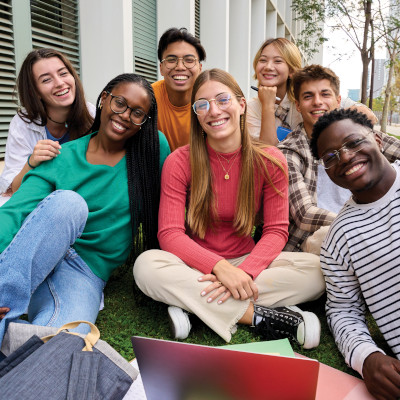 2025 DMAW/EF Online Auction!
2025 DMAW/EF Online Auction!
The 2025 DMAW/EF Auction will be held at the Bridge Conference in National Harbor, Maryland, once again this year. It will be an online auction that anyone can participate in. We look forward to seeing everyone in person and sharing more about the DMAW/EF — and also connecting with many of you online!
Have an item to donate or want to get involved with the DMAW/EF Auction? We are forming the committee and would love to have you! To donate, join the Auction committee or for more information, reach out to auction@dmawef.org.
MEMBER SPOTLIGHT

Jasmine Taylor
Independent Fundraising Consultant
taylor.jasmine23@gmail.com
When you find your calling, you know. For Jasmine Taylor, who transitioned into the fundraising and marketing space seven years ago, that’s definitely been the case.
“I’ve worked in other fields, but fundraising and marketing have always felt like home,” Taylor said. “The ability to merge technology with purpose has been my ultimate calling.”
Taylor went to Georgetown University, where she earned a degree in business and entrepreneurship. She also holds certifications in artificial intelligence (AI) applications for marketing and fundraising, which has been her focus over the past two years as she has worked to leverage AI-driven solutions to optimize campaigns and create dynamic solutions for donor acquisition and retention.
“I love using cutting-edge AI tools to create smarter, data-driven strategies that empower nonprofits to connect with their supporters more meaningfully,” she said. “It’s fulfilling to see how innovation can drive both efficiency and impactful results.”
Who do you consider your mentors?
My wife, Stephanie Jones, is my biggest inspiration. She is so bright and successful that it motivates me every day. Professionally, I also look up to leaders like Katy Jordan, Kim Searight, Joanne Wilson, Kathy Swayze, Brenna Holmes and Kat Landa, who have demonstrated the power of innovative leadership and adaptive thinking in the marketing field.
What advice would you offer a novice who wants to move up in direct marketing?
Be curious and fearless. Explore AI and emerging technologies — these tools can give you an edge in crafting highly effective campaigns. Never hesitate to reach out to mentors or attend industry events like those hosted by DMAW to broaden your knowledge and network.
What is the most helpful step you took to advance your direct marketing career?
Diving into the world of AI and data analytics has been transformative. Learning to adapt these tools for fundraising has not only elevated my career, but also helped my clients achieve exceptional results. Attending industry conferences and workshops has also been invaluable for staying ahead of trends.
QUICK TAKES
FILM: “How the Grinch Stole Christmas” (2000)
![]()
![]() RESTAURANT:
RESTAURANT:
Mi Vida
![]() MUSIC:
MUSIC:
Kendrick Lamar
![]() LEISURE INTERESTS:
LEISURE INTERESTS:
Exploring new technologies, mentoring budding professionals, and traveling with my wife and pups.

Direct Impact is the member exclusive magazine from the DMAW.
Want to be featured in a future issue? Email your article ideas to comms@dmaw.org.


